Macaron Troubleshooting
Everyday I receive emails, messages, DMs, from people who are about to give up, or feeling disheartened because they just can’t seem to make macarons work. Which is why I am putting together this Macaron Troubleshooting Master Guide!
In this Macaron Troubleshooting Guide we will cover most of the issues you may encounter while making macarons, how to identify them, how to fix them, and also, I am here to tell you that it’s ok. Making mistakes is ok. I have made all of the mistakes below myself!
It has taken me a great deal of time, practice, and devotion to learn enough information to make this macaron troubleshooting post. But to me, it was always so much fun to do this (often times frustrating, but still fun), to continue to unravel the crazy, inexact science behind making macarons.
This post may contain affiliate links. I earn a commission from qualified purchases. Please read our Privacy policy here.
Yes, it does take a great deal of science to be able to do macaron troubleshooting, however, you are better off learning that macarons are extremely particular. Two people using the exact same recipe are going to obtain very different results.
Anyway, without any further ado, let’s get to macaron troubleshooting!
I’ve divided the visual guide between two different images, so I could fit all of them and still make it possible to read without zooming in.
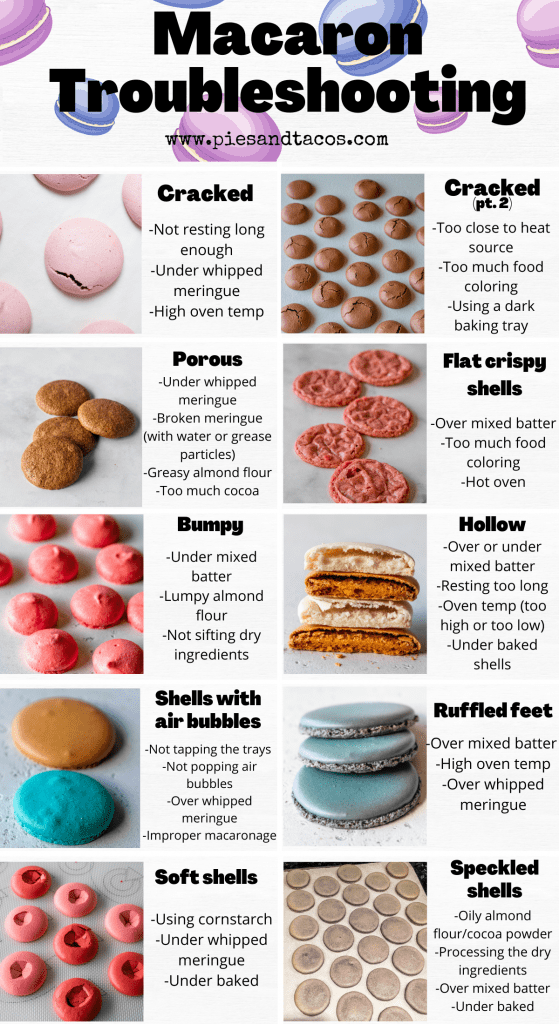
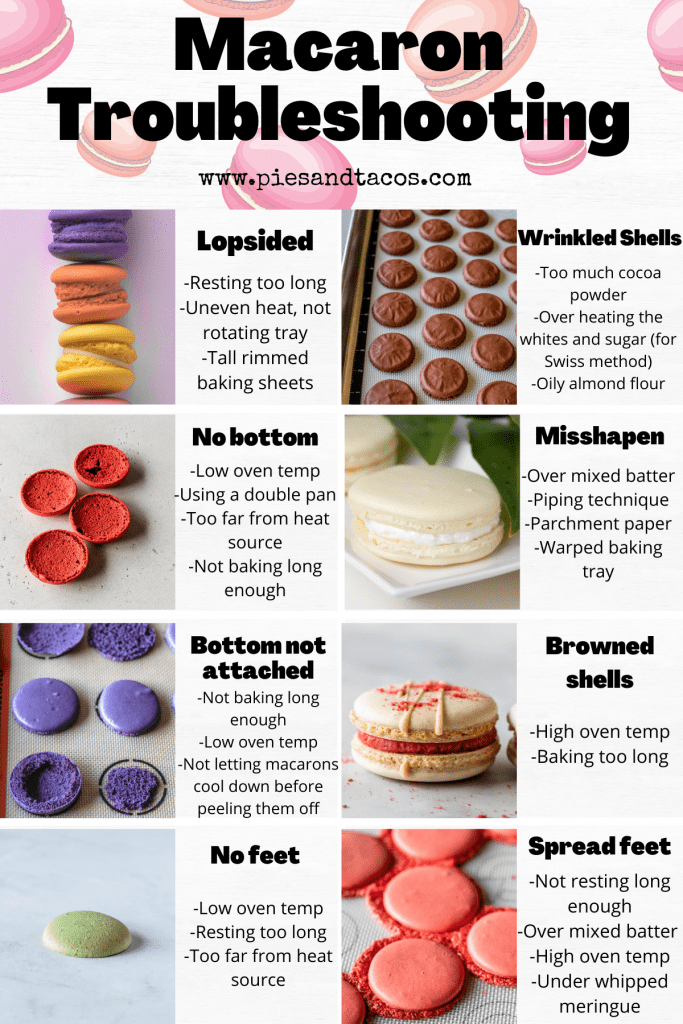
Cracked macaron shells
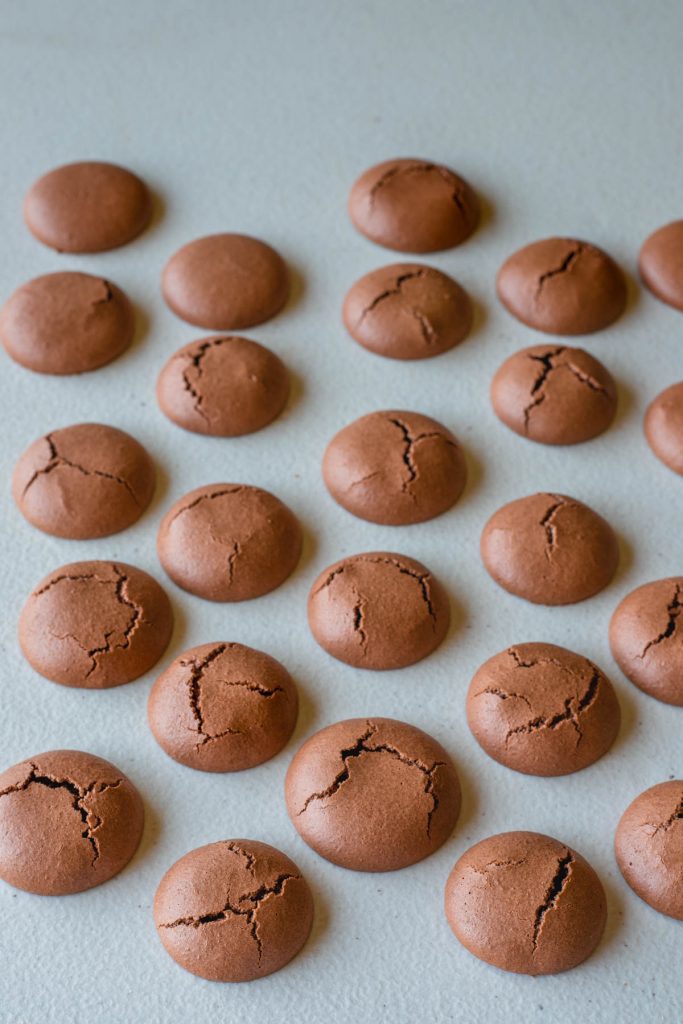
Cracked macaron troubleshooting:
- Not resting long enough. If you aren’t resting the shells long enough, it won’t give them enough time to dry, and the moisture will cause them to crack. If you are in a humid climate, it might be worth it checking out a recipe that doesn’t even require resting, if the humidity is too high, it might be absorbed by the macarons, making matter worse. How to know the macarons have rested enough: the macaron surface looks dull in color, and if you touch them with your finger, they shouldn’t stick. If the macarons have a lot of food coloring, they might need a bit more resting, though, so leave it for another few minutes.
- Under whipped meringue may be the culprit for cracked macaron shells. That’s because the meringue isn’t strong enough. Always make sure the meringue is at stiff peaks before adding the dry ingredients in.
- High oven temperature. In this case, make sure to have an oven thermometer, also consider experimenting with lower temperatures.
- Too close to the heat source. The position of your baking tray matters a lot when baking macarons. Experiment to find out what’s the optimal place to put your baking sheet in the oven. If the baking sheet is too close to the heat source it may cause the macarons to crack. I bake my shells in the middle of the oven.
- Too much food coloring will cause the macarons to crack because of the high moisture level in the shells. Macarons can’t have too much moisture in them, which is why we usually rest them, because that helps them dry a bit. If you add a lot of food coloring, consider a longer resting time before baking. Also, make sure to always use gel or powder food coloring, as liquid food coloring adds a lot of moisture to the shells and the results may be disastrous.
- Using a dark baking tray may cause cracked shells, because dark trays retain more heat. And too much heat may crack the macarons. Always go for silver baking trays. Also, if you are using teflon sheets to bake the macarons consider turning the temperature of the oven down, since they tend to conduct more heat. The surface you use for baking macarons matters a lot!
Porous macaron shells
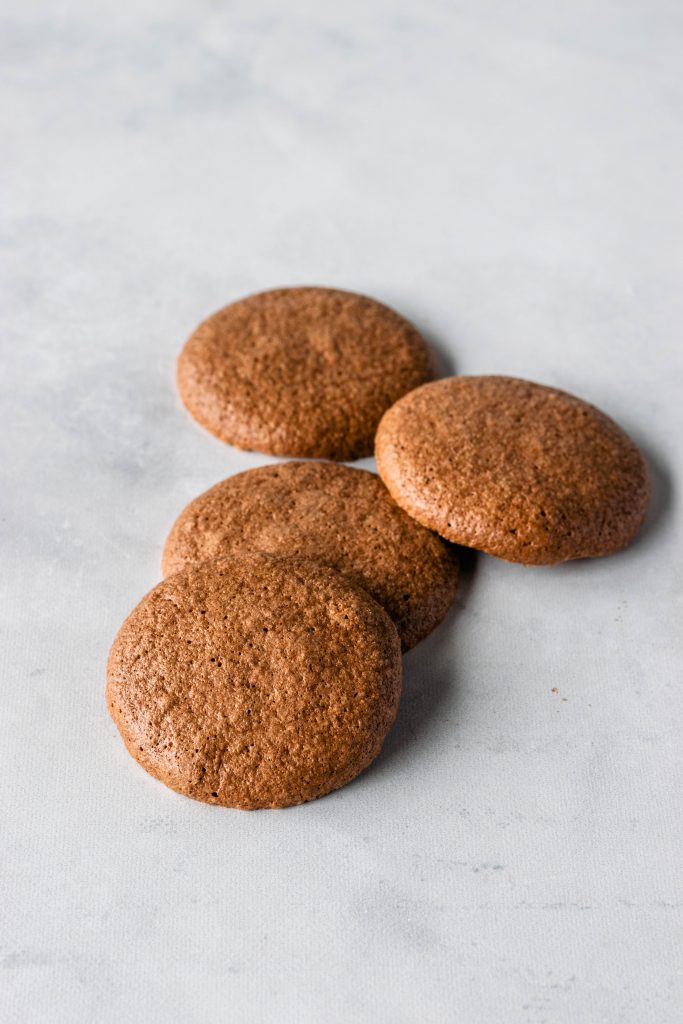
Porous macaron troubleshooting:
- Under whipped meringue can cause porous shells, because the meringue isn’t strong enough. Make sure the meringue is whipped to stiff peaks, peaks that are shooting straight up. Read more about the meringue here.
- Broken meringue with grease or water particles. Wipe the bowls, whisk, spatulas, baking mats, and the materials you will be using with vinegar to get rid of any grease particles. Don’t use plastic bowls, as they may retain grease on their surface. Make sure not to get water drops on the meringue or batter. Also, be careful not to get any yolk bits in the whites before you make the meringue.
- Greasy almond flour. Make sure the almond flour you are using is dry. Also, avoid processing the almond flour in the food processor before using it, because once the almond gets processed too much, it begins to release grease.
- Too much cocoa powder. Often times cocoa powder may also have a high fat content, which is why too much of it may cause porous shells.
Flat crispy macaron shells
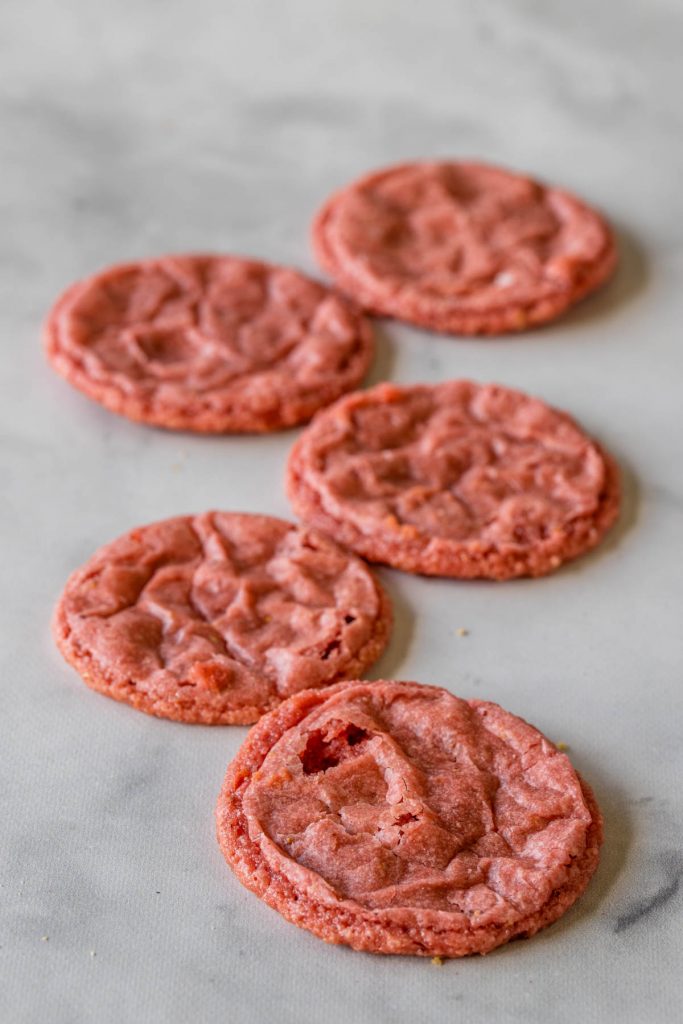
Flat and crispy macaron shells may happen for a few reasons, let’s see why.
- Over mixed batter may be causing your shells to go flat and crispy. The over mixed batter will spread out as it bakes and will become flat, and if you combine that with a hot oven temperature, the shells will crisp up. Fold until the batter is flowing slowly but effortlessly off the spatula, if it’s flowing too quickly, and mixing back in too fast with the batter in the bowl, then you have probably over mixed. Watch my many videos on YouTube where I show the perfect macaronage stage.
- Too much food coloring may cause this as well, because it’s added moisture, just like in the case of the over mixed batter. Make sure to use gel or powder food coloring, and if you are a beginner, go very easy on the food coloring at first.
- Hot oven may also cause flat and crispy shells to happen, as the hot oven will explode the macarons, causing them to lose all air and deflate. Always have an oven thermometer, and experiment with your temperatures and baking time in order to find out what works best for you.
- Adding “unusual” ingredients to the shells. When I have added freeze dried strawberry powder to my shells, this happened. Now, there is a safe amount you can add and still keep your shells intact and perfect, however, I believe I have added too much in that case. Always follow the recipe and see what the amount of freeze dried fruit powder the recipe is calling for. If you are a beginner, consider skipping this and keeping your shells as plain as possible until you master the technique. Also, be careful with what ingredients you add to the shells. Things such as cinnamon powder, turmeric, may cause the shells to crack or deflate as well.
Bumpy macaron shells
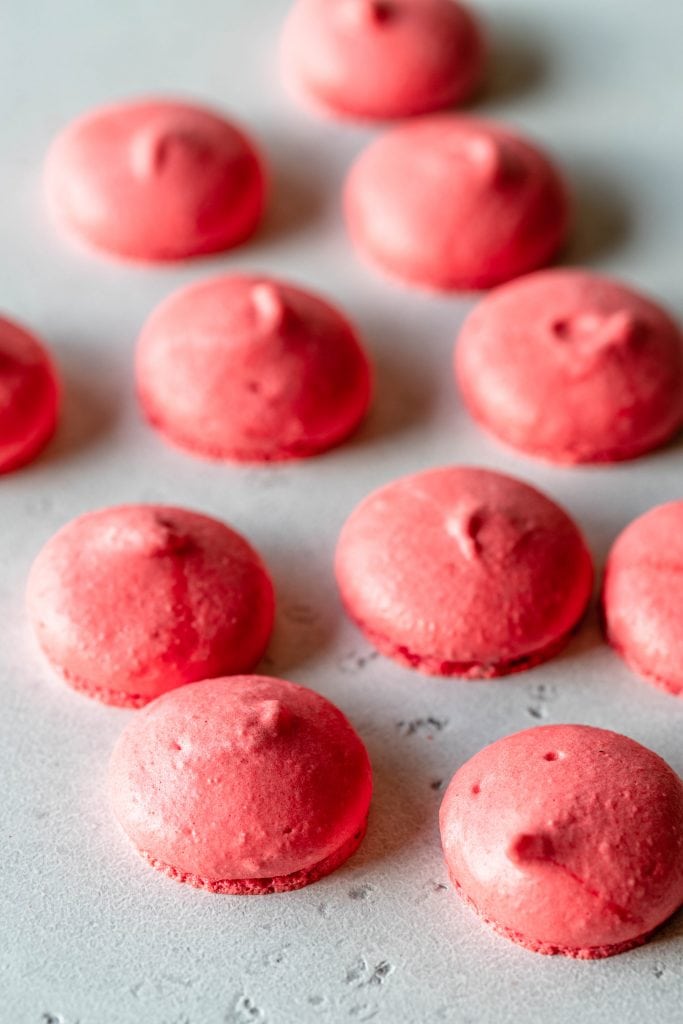
Bumpy macaron troubleshooting:
- Under mixed batter is the most probable cause for bumpy shells. You should make sure to mix the batter until it’s flowing slowly and effortlessly off the spatula. And you should be able to pick up some batter with the spatula and draw a few figure 8s with the flowing batter without it breaking up. Watch my many videos on YouTube to see this perfect stage.
- Lumpy almond flour may be causing the shells to not be smooth as well. You should look for a brand of almond flour that is dry and finely ground. I do not recommend processing the almond flour in the food processor as that may make the it release oils, which will cause other issues.
- Not sifting the dry ingredients can cause your shells to be bumpy. Always make sure to sift the dry ingredients with a fine mesh sieve. Some people like to sift their dry ingredients two or three times to make for a really fine almond flour/powdered sugar mixture.
Hollow macaron shells
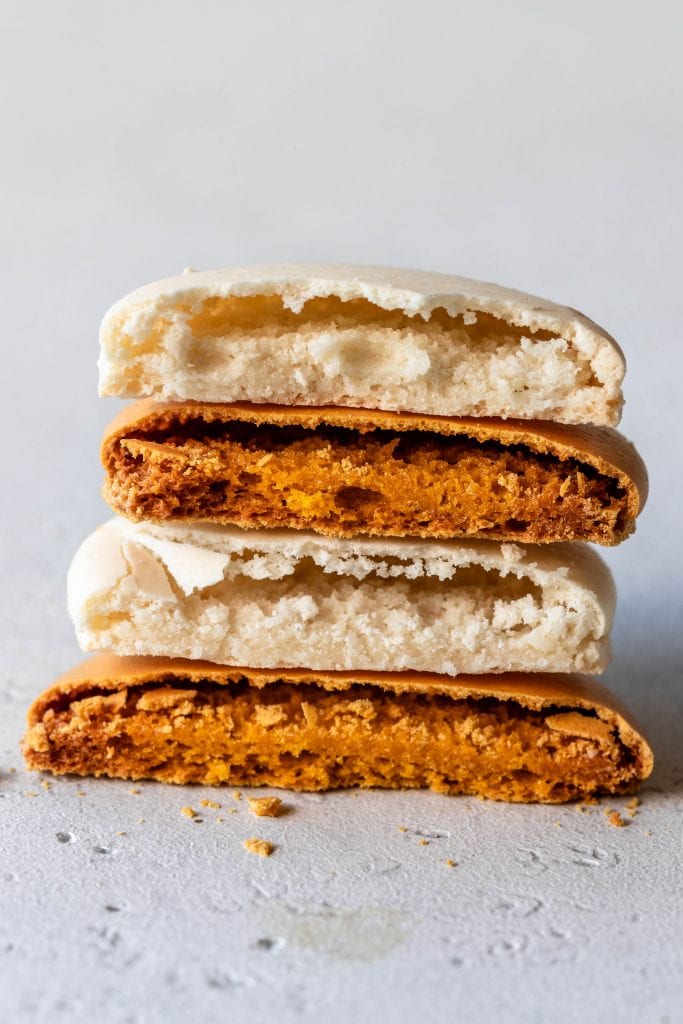
Please read the blog post I wrote on why your macaron shells are hollow. As I was writing this macaron troubleshooting guide, the explanation about hollow macarons got really long, and I felt like it deserved its own post so I could go into detail!
Click here to read about hollow macaron troubleshooting!
Shells with air bubbles
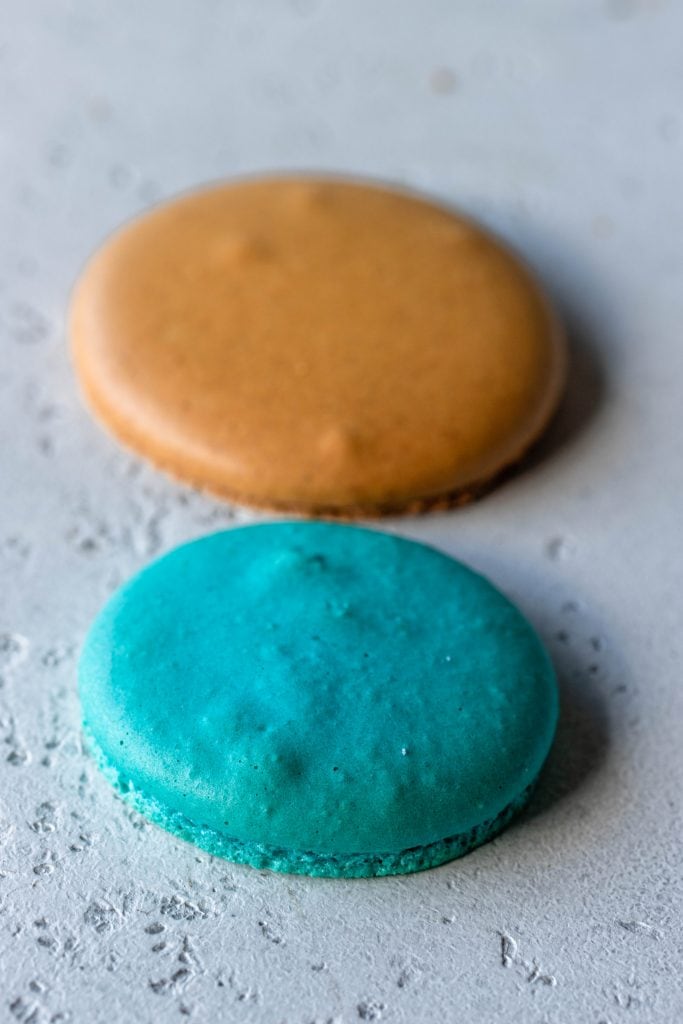
If your macaron shells have air bubbles in them that’s a really easy fix. Check it out.
- Not tapping the trays after piping the shells may cause air bubbles. Make sure to do that after piping your shells. Just a few times against the counter will do the trick. I like to place a towel under the baking sheet before tapping the trays, so it’s not so loud.
- Not popping air bubbles after piping the shells and tapping them against the counter. Use a toothpick to pop any remaining air bubbles on the surface of the macarons. Make sure to do so before the macarons have a chance to dry.
- Over whipped meringue sometimes may cause you to have a batter with a lot of air in it, and then the surface of the shells will have lots and lots of bubbles.
- Improper macaronage. If you don’t deflate enough air out of the batter, it may cause the shells to have a lot of air bubbles. Sometimes the batter needs a “rougher macaronage”, instead of a delicate folding. And it’s not about folding more, but about folding intentionally in order to deflate the batter. While you are macaronaging, press the batter against the walls of the bowl, in order to get the air out.
Ruffled feet
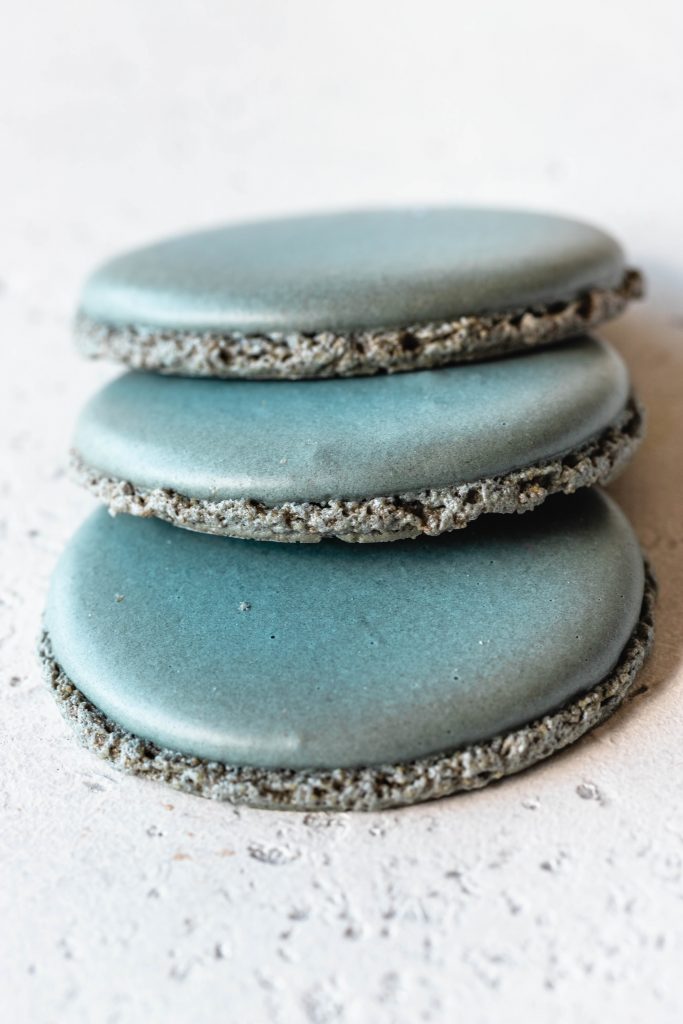
Let’s see what causes those ruffled feet! When the feet just go past the diameter of the top shell, they spread out slightly, look frilly, and a bit larger than they should be. Here are some possible causes:
- Over mixed batter may be the culprit. Sometimes the feet will spread all the way out as we will see below, but often times it will be just enough so that the feet get frilly like this. The trick is to master the macaronage. Fold until the batter is flowing slowly but effortlessly off the spatula, if it’s flowing too quickly, and mixing back in too fast with the batter in the bowl, then you have probably over mixed. Watch my many videos on YouTube where I show the perfect macaronage stage.
- High oven temperature may cause the feet to get too tall, and then spread out to the side as the macaron bakes. Also if you are using dark baking sheets it can do the same thing, as the dark sheets retain more heat. Make sure to have an oven thermometer, and experiment with lower temperatures.
- Over whipped meringue may often cause the feet to become very tall because of all the air in the shells, and then when the macaron bakes, the high amounts of air in the shells will make the feet expand. Make sure the meringue is at stiff peaks, and stop whipping when you reach peaks that are shooting straight up.
Soft shells
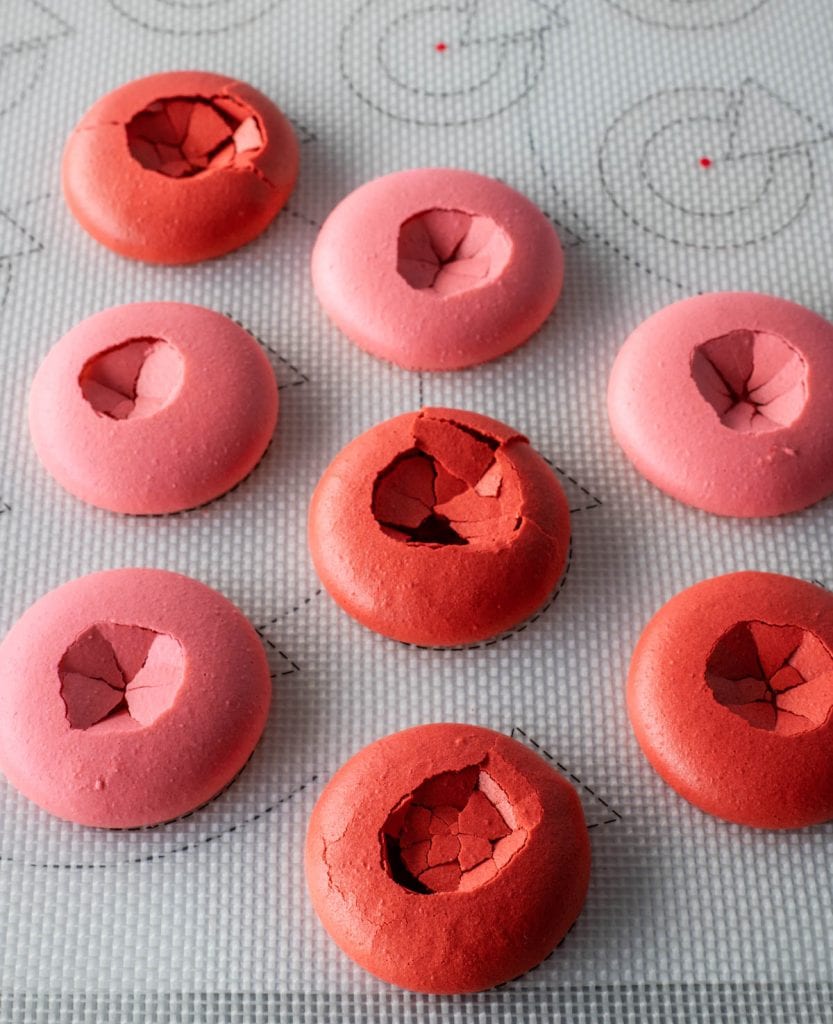
Soft macaron shells are also a very common issue I see happening. If the skin on top of your macarons is paper thin, super delicate, breaking easily, your shells are too soft.
That can be caused due to a few things:
- The use of cornstarch may soften up the shells. Often times people use cornstarch to obtain fuller shells, or to help their shells dry, that’s because cornstarch acts as a stabilizer for the meringue. Cornstarch prevents the protein bonds in the egg whites from tightening, which happens if you over whip the meringue. It can be very useful to add to your macarons if you use the French method. Like I use on this no-rest French method recipe. However, sometimes the cornstarch might be causing your shells to be too soft, by making the meringue too weak and by preventing those same protein bonds to form and strengthen. Either reduce the amount of cornstarch, omit altogether, or make absolute sure to be whipping to stiff peaks.
- Under whipped meringue can be causing soft shells for the same reason as the use of cornstarch is: because a soft meringue won’t be strong enough to provide a solid structure to your cookies. Make sure the meringue has peaks that are shooting straight up.
- Under baked shells will be soft and fragile, since they won’t have had time enough to develop a nice sturdy skin. To know when the macarons are done baking, wiggle one shell and if it jiggles continue to bake it. You may also want to cut a macaron in half, and if it’s gooey in the middle continue to bake. Sometimes macarons with a lot of added food coloring need longer baking time.
Speckled shells
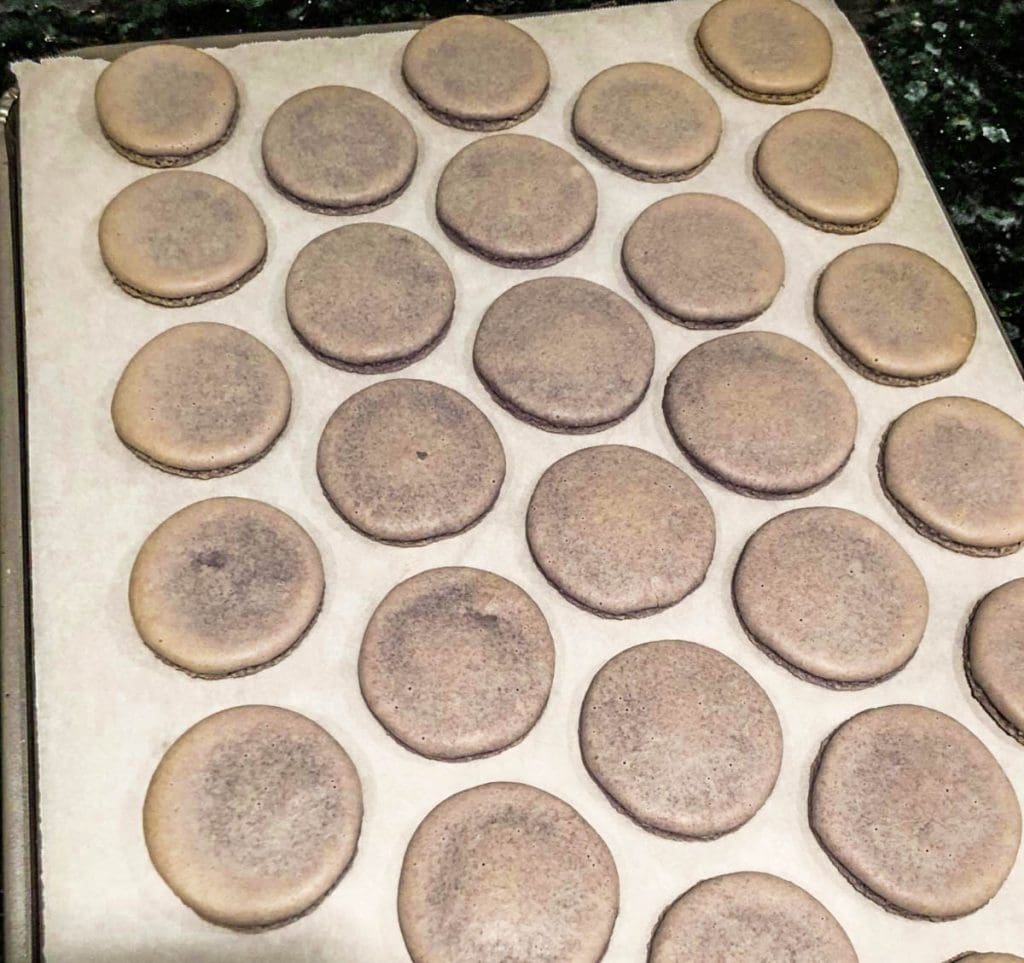
Speckles macaron troubleshooting:
- Oily almond flour/ cocoa powder may cause speckled shells. Make sure your ingredients aren’t oily. Both almond flour and cocoa powder have a high percentage of fat, and fat doesn’t go well with meringue. If the almond flour or the cocoa powder are particularly more oily than normal, due to the brand you are using, or because they have been sitting for a while and have released oils, then they may cause speckled shells. Check your ingredients, touch them with your fingers, make sure they are dry and not greasy.
- Pulsing the dry ingredients in the food processor will cause speckled shells for the same reasons why I mentioned above, because if you process the dry ingredients in the food processor, that may start to release the oils in the almond flour. I really don’t ever process my ingredients, as I see no benefit to it, and it poses a risk. Just make sure to sift the ingredients instead of processing them, and if the almond flour you are using isn’t finely ground, switch brands and find one that is.
- Over mixed batter may cause speckled shells because the batter will be too wet and runny. Too much moisture in the batter may cause this issue. Fold until the batter is flowing slowly but effortlessly off the spatula, if it’s flowing too quickly, and mixing back in too fast with the batter in the bowl, then you have probably over mixed. Watch my many videos on YouTube where I show the perfect macaronage stage.
- Under baked shells often become speckled as they cool down, because the inside is gooey and didn’t get a chance to bake and fully dry. To know when the macarons are done baking, wiggle one shell and if it jiggles continue to bake it. You may also want to cut a macaron in half, and if it’s gooey in the middle continue to bake.
Lopsided macarons
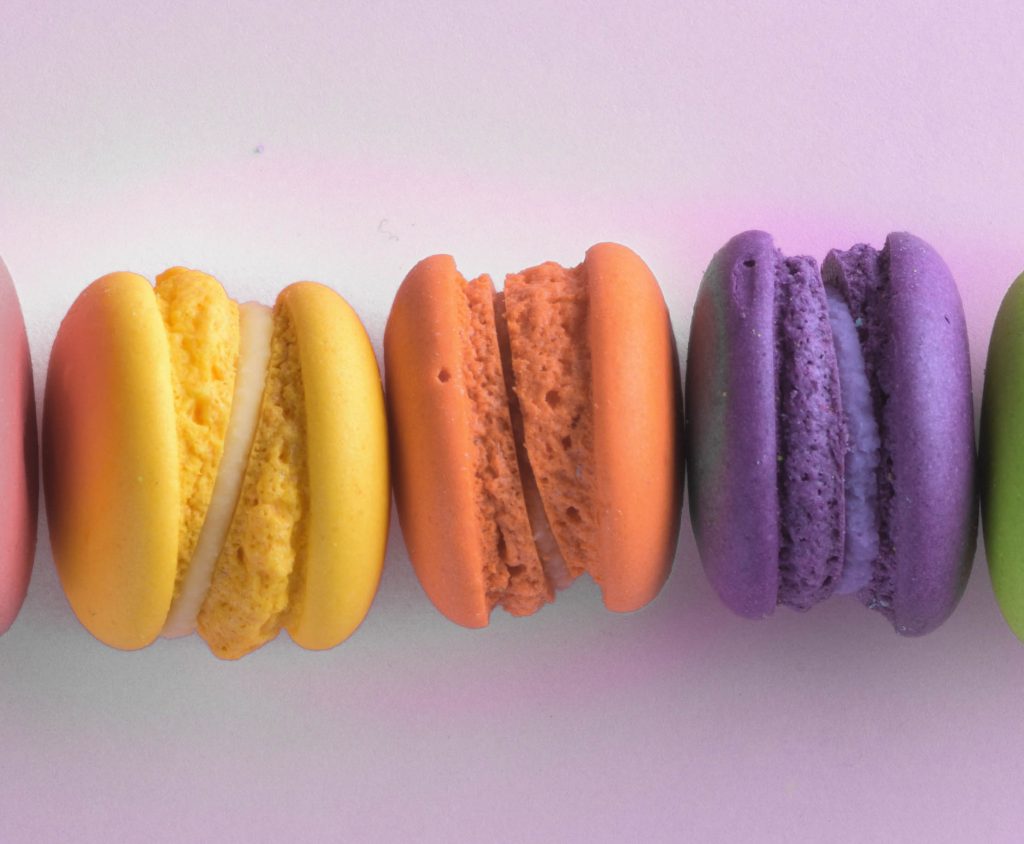
Lopsided macaron troubleshooting:
- Resting too long may may be the cause of lopsided macarons, because if the shells rest for too long before baking the protein structures begin to deflate, causing the shells to bake unevenly.
- Uneven heat is the biggest culprit for lopsided macarons. If you have this issue, make sure to rotate the trays as they bake, so they are baking evenly on all sides. It’s important to find out if your oven has any hot spots, and if the heat distribution is good. You can do this by placing oven thermometers in your oven and taking note of their temperature.
- Tall rimmed baking sheets also won’t let the heat be distributed evenly in the oven. If your trays have tall rims, you can flip them around and place your baking mat or parchment on the bottom of the tray. This is a tip I learned from Bake Toujours.
Wrinkled shells
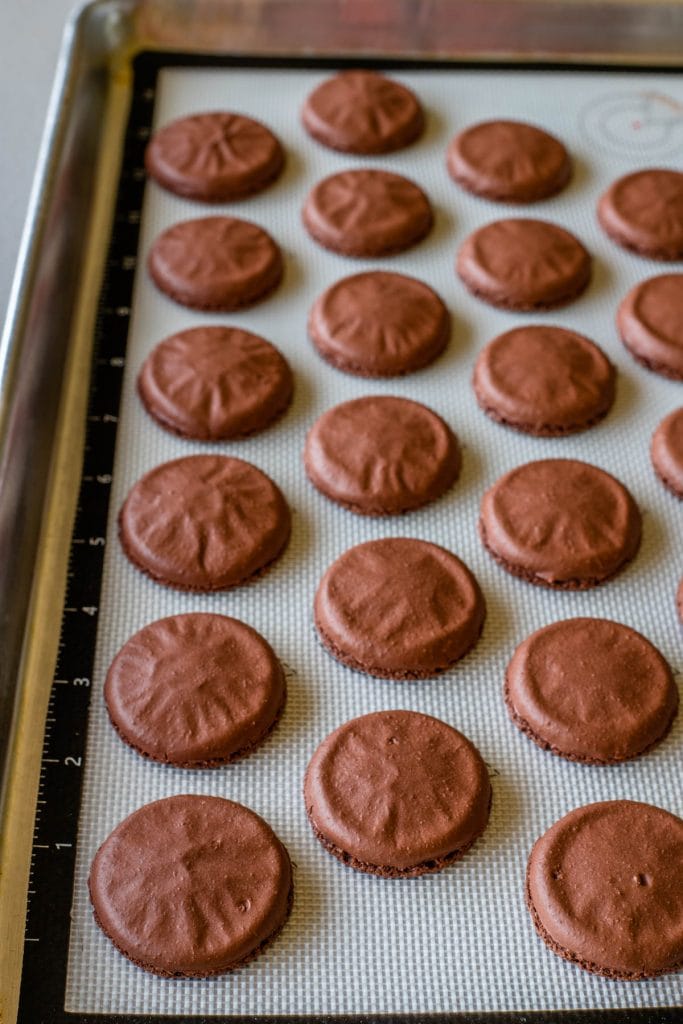
Why are my macarons wrinkled?
- Too much cocoa powder can cause the shells to become wrinkled because cocoa powder has a high fat content and it absorbs a lot of liquid as well, and it’s also acidic, so all of those factors will affect the meringue and the batter. If the batter is too thick, the shells may become wrinkled when you bake them. And oily batter will also become wrinkled which brings me to the next item. Consider using low fat cocoa powder, or using less of it.
- Oily almond flour can also cause wrinkled shells because of the way the fat particles interact with the meringue and make the protein bonds that form the structure of the meringue weaker. If you process the almond flour in the food processor stop doing that. Look for a brand of almond flour that is dry, and finely ground.
- Over heating the sugar and egg white syrup (if using Swiss method) will cause wrinkled shells because when you heat the sugar and egg whites too much, the meringue will end up being super stiff, and the stiff meringue will also form a super stiff batter, that will wrinkle as it bakes. Heat the sugar and egg whites just until the sugar melts and you can touch the syrup with your fingers and not feel any sugar granules.
- Over mixed batter. Fold until the batter is flowing slowly but effortlessly off the spatula, if it’s flowing too quickly, and mixing back in too fast with the batter in the bowl, then you have probably over mixed. Watch my many videos on YouTube where I show the perfect macaronage stage.
Macaron shells with no bottom
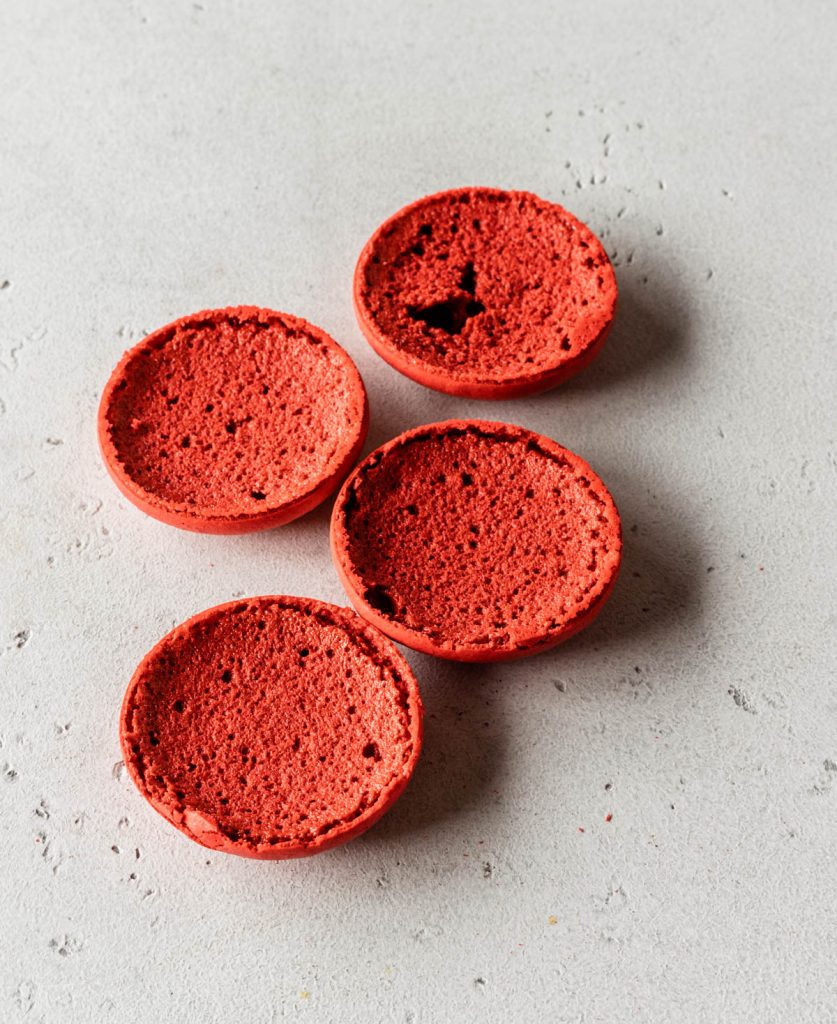
If your macarons have no bottom, here are some of the reasons why:
- Low oven temperature may be causing your macarons to have no bottoms because it’s not giving them a chance to bake fully and develop the bottom of the shell. Always have an oven thermometer, and experiment with your temperatures and baking time in order to find out what works best for you.
- Using a double pan. A couple of years ago my macarons had feet that would explode to the sides, so I decided to use a double pan because if I lowered the temperature, they wouldn’t form a bottom skin. It turns out they also didn’t get bottoms with the double pans. And my issue was on the macaronage actually. But just note that if you do use a double pan, that might be the cause for the bottoms not to be developing due to the lack of heat.
- Being too far from the heat source will also cause the macarons to not develop a bottom for the same reasons as the factors above: not enough heat. Experiment with different rack levels.
- Not baking the macarons long enough. This is an easy fix, bake the macarons until they are fully baked. To know when the macarons are done baking, wiggle one shell and if it jiggles continue to bake it. You may also want to cut a macaron in half, and if it’s gooey in the middle continue to bake. Sometimes macarons with a lot of added food coloring need longer baking time.
Misshapen macaron shells
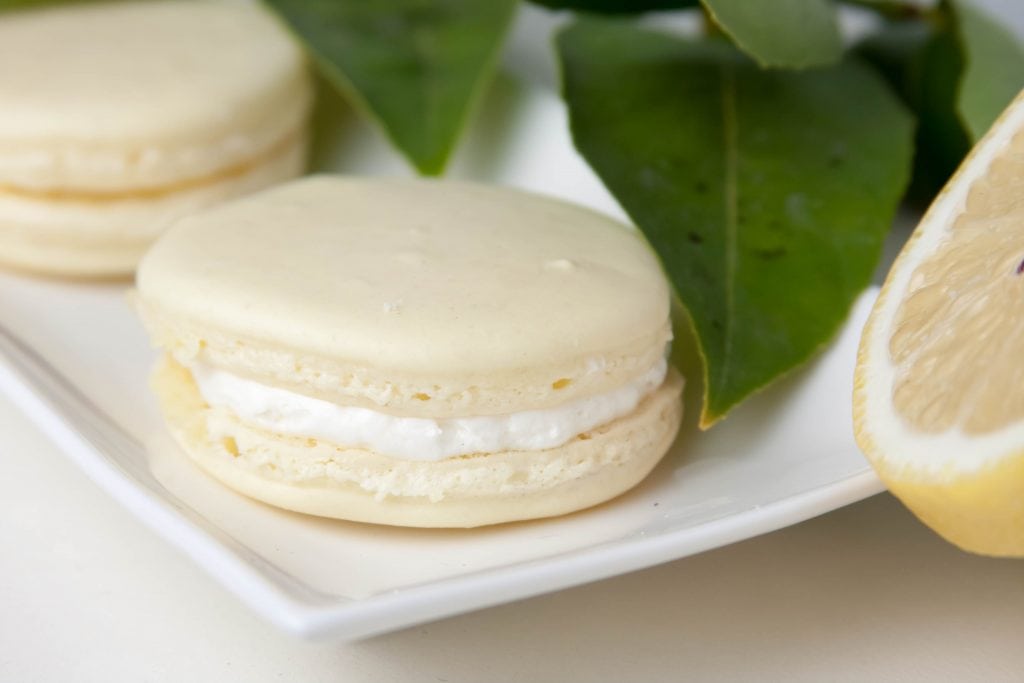
Misshapen macarons are shells that aren’t perfectly round, with a weird shape. Here are some reasons why that happens:
- Over mixed batter. In that case the shells will lose the round shape because of the batter being so liquidy. Fold until the batter is flowing slowly but effortlessly off the spatula, if it’s flowing too quickly, and mixing back in too fast with the batter in the bowl, then you have probably over mixed. Watch my many videos on YouTube where I show the perfect macaronage stage.
- Piping technique is important to obtain round shells. Place the piping bag directly 90 degrees over the center of a circle template. Apply gentle pressure for about 3 seconds, then quickly pull the bag up, twisting quickly at the top. This may take some practicing, and you can use your other hand to assist you. Also worth checking if your piping tip is perfectly round and not warped.
- The use of parchment paper may cause shells to be misshapen because the parchment paper wrinkles as soon as you pipe the shells on it, due to the moisture. So the parchment paper is not a flat sturdy surface such as silicone mats or teflon sheets. I know a lot of people vouch for parchment paper, but I never found a brand that would not wrinkle, which is why I use silicone mats.
- Warped baking trays. If your tray is warped make sure to get a new one and replace it. Over time, the constant heating, and cooling down, and also the tapping of the trays against the counter will cause them to get warped and you will need to replace them.
Bottom not attached
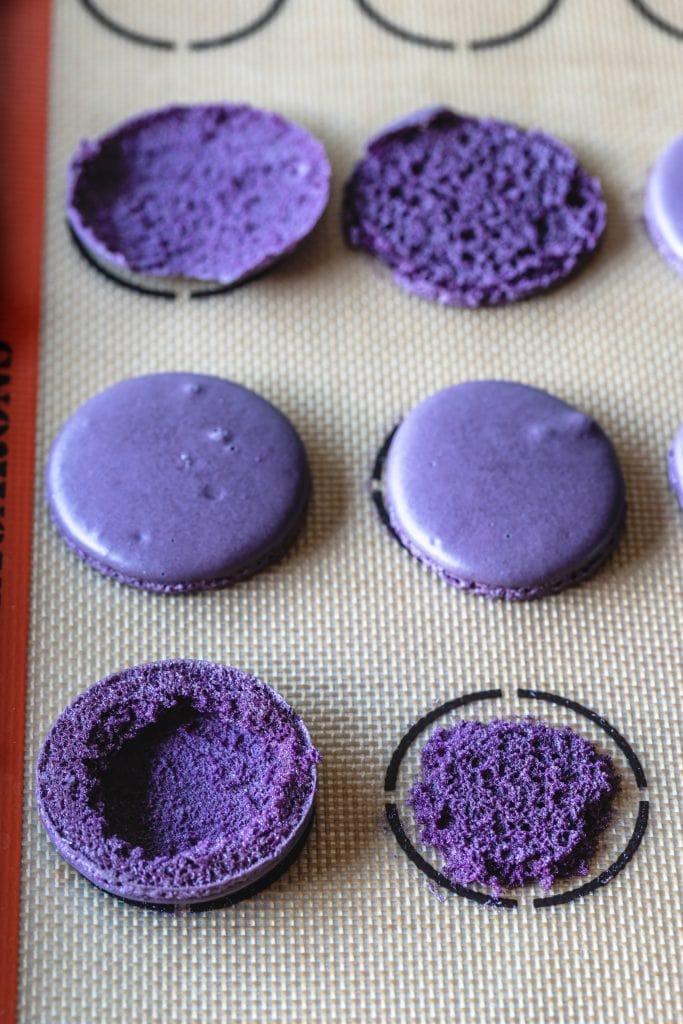
Much similar to the case of the macaron shells with no bottoms, it’s mostly due to a heat issue that the bottom will not be attached to the top of the shell.
- Not baking the macarons long enough may cause them to be too gooey on the inside and not have the top be attached to the bottom. This is an easy fix, bake the macarons until they are fully baked. To know when the macarons are done baking, wiggle one shell and if it jiggles continue to bake it. You may also want to cut a macaron in half, and if it’s gooey in the middle continue to bake. Sometimes macarons with a lot of added food coloring need longer baking time.
- Low oven temperature may be causing your macarons to have the top detached from the bottom, because they don’t have the chance to bake fully and develop. Always have an oven thermometer, and experiment with your temperatures and baking time in order to find out what works best for you.
- Not letting the macarons cool down before peeling them off the mat may also cause this issue. Make sure to let the macarons cool down completely before removing them from the mats.
Browned macaron shells
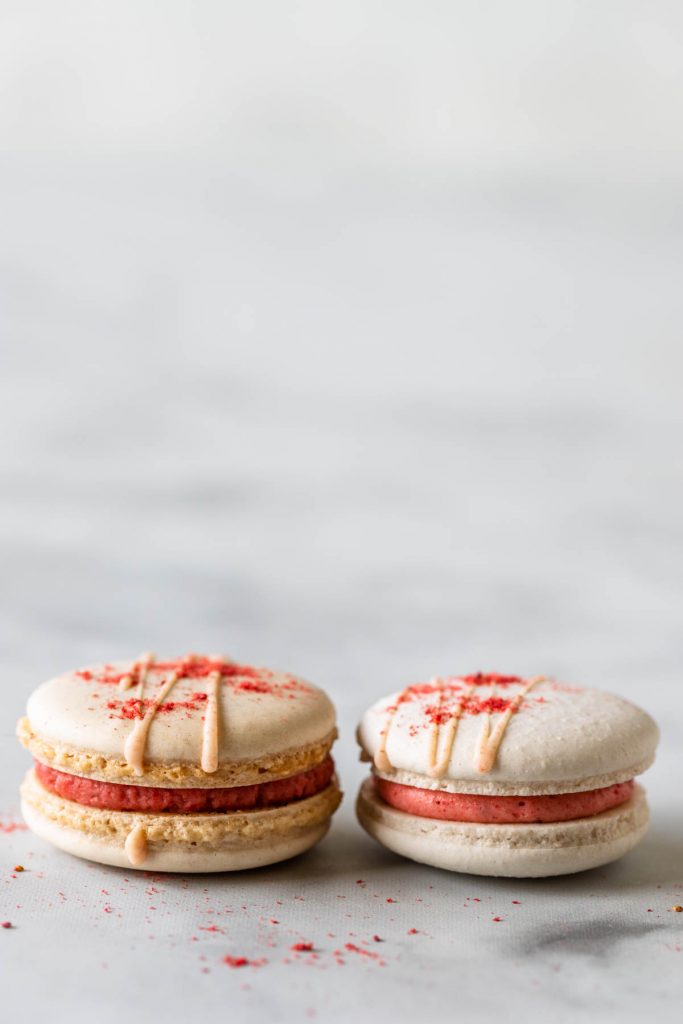
If your shells are browning in the oven and losing their vibrant color, I have the perfect browned macaron troubleshooting for you!. First let’s look at a couple of reasons why that might be happening:
- High oven temperature will often cause the shells to brown too much. In this case, make sure to have an oven thermometer, also consider experimenting with lower temperatures.
- Baking the macarons for too long will certainly make them browned, and will make them lose the vibrant color.
A great fix for browned macarons is to cover the shells with foil after 7 minutes baking. As you can see on the picture above, the macaron shells on the left were baked without being covered with foil, and the shells on the right were covered with foil, and kept a white color.
Macarons with no feet
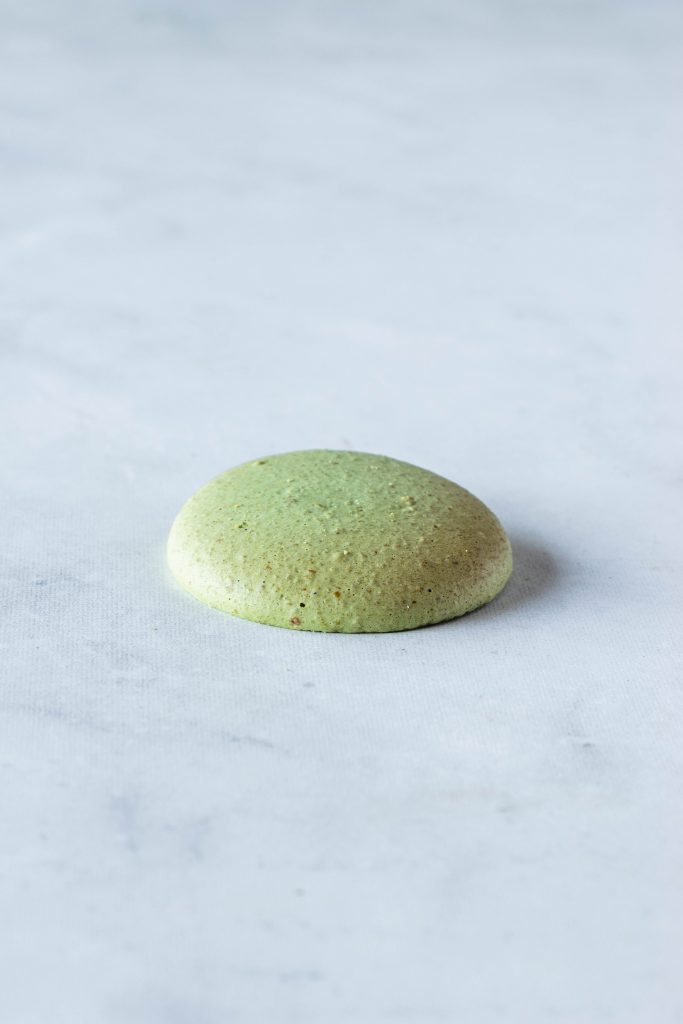
Why do my macarons have no feet?
- Low oven temperature can cause the macarons to have no feet. Always have an oven thermometer, and experiment with your temperatures and baking time in order to find out what works best for you.
- Resting too long can be the culprit for the absence of feet in macarons, because if the shells rest for too long before baking, the protein structures begin to deflate, causing the macarons not to develop properly in the oven.
- Being too far from the heat source may cause macarons to have no feet because, like with the low oven temperature case, the lack of heat won’t give the macarons a chance to form the feet and bake properly. Experiment with different oven rack positions to find out what works best.
Feet that spread out
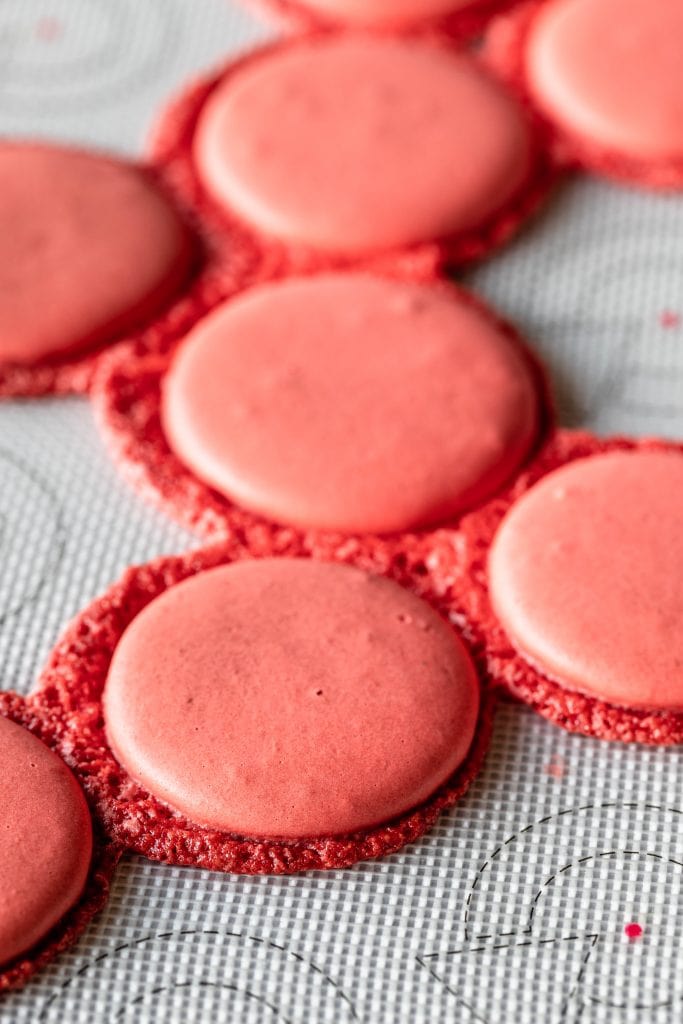
Why are my macaron feet spreading out to the sides? Exploding feet can be caused by several different circumstances, let’s take a look:
- Not resting long enough: If you aren’t resting the shells long enough, it won’t give them enough time to dry, and the moisture will cause them to crack. If you are in a humid climate, it might be worth it checking out a recipe that doesn’t even require resting, if the humidity is too high, it might be absorbed by the macarons, making matter worse. How to know the macarons have rested enough: the macaron surface looks dull in color, and if you touch them with your finger, they shouldn’t stick. If the macarons have a lot of food coloring, they might need a bit more resting, though, so leave it for another few minutes.
- Over mixed batter. Master the macaronage to stop having this issue. Fold until the batter is flowing slowly but effortlessly off the spatula, if it’s flowing too quickly, and mixing back in too fast with the batter in the bowl, then you have probably over mixed. Watch my many videos on YouTube where I show the perfect macaronage stage.
- High oven temperature may cause the feet to get too spread out. Also if you are using dark baking sheets it can do the same thing, as the dark sheets retain more heat. Make sure to have an oven thermometer, and experiment with lower temperatures. It’s very important to understand how your oven works, check this post out.
- Under whipped meringue may often cause the feet to spread out in the oven because the batter will be super liquidy, and the meringue structure will be weak, and unstable. If you under whip the meringue, it will not have enough air in it, and it also won’t have enough of the protein bonds necessary to form a stable and strong structure for the macarons. Make sure the meringue is at stiff peaks, and stop whipping when you reach peaks that are shooting straight up.
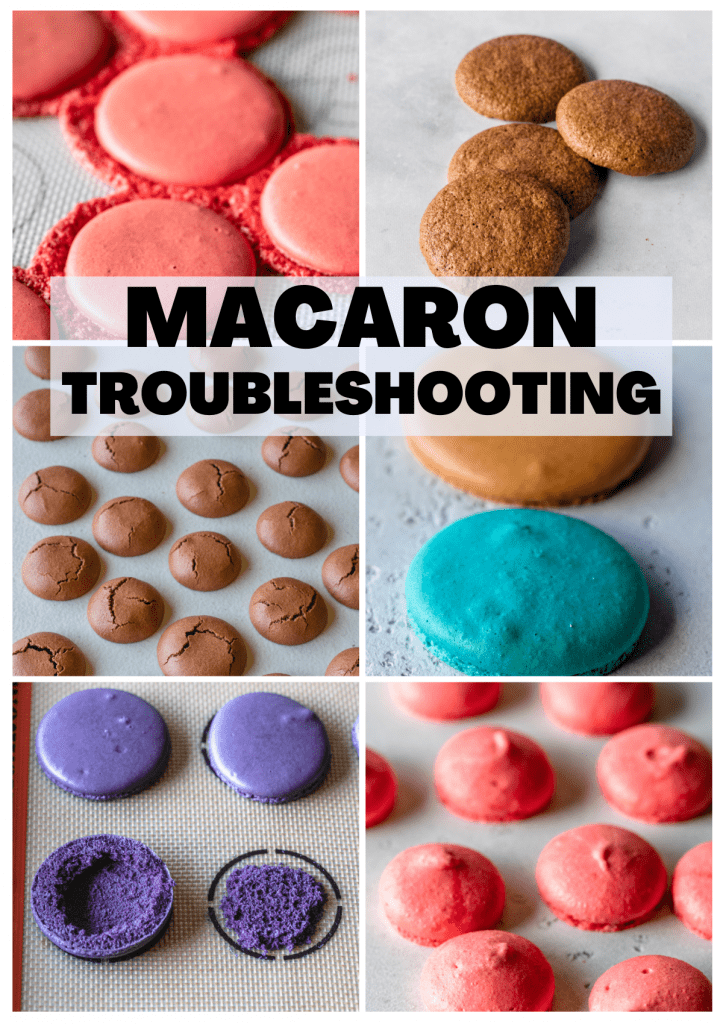
To read more informative posts like this Macaron Troubleshooting Guide, visit Macaron School.
Here are some posts that might interest you:
- The most important stages of making macarons
- How to make perfect macarons
- Frequently asked questions
- Understanding your oven
- Macarons for beginners
- Tools I use to make macarons
- Vegan Macaron Troubleshooting
- Meringue lesson
- Hollow macarons
And for my whole list of macaron flavors please click here.
Also visit my YouTube channel, where I post macaron videos every week!
I hope you enjoyed and learned a lot from this Macaron Troubleshooting Guide!
Thank you for reading!



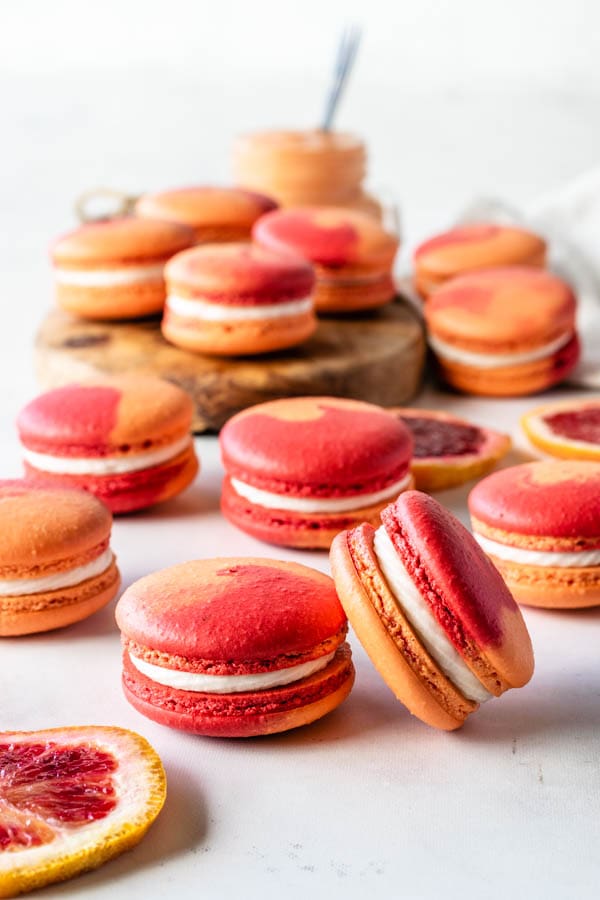




This was so helpful! I am a beginner and I was so confused why my feet were spreading but after looking at the guide I am pretty sure my meringue was under whipped and my oven may have gotten too hot.
Im so glad the guide is helpful!! Thank you!
Hello! Thankful for all your tips! Any recommended almond flour brands? not all brands are created equal 🙂
i love blue diamond the most, and second in my list is bobs red mill.
What oven thermometer do you use? I purchased one but the temperature kept changing and I wasn’t sure how to tell the correct temperature. Thanks!
I use the kitchenaid one usually but I have used several different ones.
What do you mean by the temperature keeps changing? Could it be that the temperature of your oven is going up and down? What kind of oven is it, how old is it?
Hi. Just wondering what brand of silicon baking mat you use. Your posts are just beautiful!
The brand you see me using in most videos is not available for purchase anymore, I loved them! I hope they start selling again. But I have recently started using silpats, I love them.
Thank you for the your macaron school and trouble shooting tips. Made me confident to start doing macarons again. I just want to say I hope you make a book for all the macarons on your website. including the macaron school. I would definitely buy them and I’m sure it will sell great
Thank you for the macaron school and trouble shooting tips. Made me confident to start doing macarons again. I just want to say I hope you make a book for all the macarons on your website. Including the macaron school. I would definitely buy them and I’m sure it will sell great
That’s amazing to hear Genny! And yes, that book will be coming out soon! Thank you so much!!! 🥰
Hi! I just find out your page and it’s the most helpful one, I could find. Thank you so much. I have a question, I have been baking macarons 2 years, and with my new oven I am having lots of problems. I solved most of them, but I don’t understand why my Macaron’s bottom are with hollows. And other question is you wrote for getting brown we should cover with foil. Do we need to put on exactly on macarons or another layer of oven?
I have a full post on hollow macarons here: https://www.piesandtacos.comhollow-macarons/
And about the foil, I put them directly on top of the macarons, you can see how I do it here on this video: https://www.youtube.com/watch?v=NHyDhnYdmX8&t=459s at minute 7:00.
Hi! My macarons turned our flat and porous. I was wondering what would be the best way to determine if my cocoa or my almond flour are oily?
The fact that they turned out flat and porous could be an indication. If your cocoa powder is old for example, I’d just get a fresh box. And as far as the almond flour goes, sometimes it will feel oily or clump up as you touch it, but other times it won’t do that but it will still have released enough oils to spoil your batter, so what you can do is you can spread the almond flour on a baking sheet, and bake it at a 200 Fahrenheit oven for about 30 minutes, remove it, let it cool down, and then use it.
Also depending on the brand of cocoa you are using it could be the issue. Cocoa powders with high fat content may turn your macarons wrinkly or porous, so check the fat content of your cocoa powder.
Thank you for the reply!
My cocoa powder is Dutch-processed and has 12-14% fat. Is that too high? I just got it actually so it is quite new.
Would it be good practice to always dry the almond flour regardless of whether or not it seems oily?
SUPER high, I use 1% fat cocoa powder.
I don’t dry my almond flour almost never, unless I know I am using a bag that has been in my cupboard for a few weeks, or if I notice it’s a bit clumpy and moist.
Hi Camila,
I am so happy that I found your site. I wanted to make a surprise Macaron box this year for members of my family, so I checked many recipes, have a book from Pierre Herme, prepared everything in advance and with the first attempt (using the Italian meringue) I failed dramatically. I started to search for the possible reasons and your site helped a lot. Yesterday I tried your pistachio macarons (using only almond flour) and finally had some success.
But not completely. So they turned out slightly brown, lopsided, some of them cracked, but all in all better than the first version. I split the quantity in three batches to experiment with the temperature and position in the oven, as well as with or without fan, but so far no big difference. Now I have some questions:
1. The oven temp – I baked them at 165C (with fan) and at 160C (with and without fan) but they turned out brown already at the 7th minute. I baked them 10 minutes in total, as otherwise the bottoms would not cook. I understand that obviously 160C in my oven is still too high, so up to what temp down would you recommend to try? I saw in some recipes calling for 140C.
2. The feet rise good up until the 5 minute mark and then they simply deflate and go smaller and smaller. After I take them out of the oven the continue going down. What could be the reason?
3. Covering with foil after 8 minutes – would the opening of the oven won’t cause the macarons to deflate?
I would be very happy to hear your comments.
Hello Yulia,
yes 160 is way too high for convection oven, it’s best to reduce the temp by 10% of what the recipe is calling for as a rule of thumb, so it would be 140. Start experimenting there.
The reason the feet might be deflating could be because of the oven temperature after all the macarons are getting a sudden lift as they go in the oven due to the high heat, but they can’t maintain the lift since the middle isn’t baking at the same speed, so they deflate.
And covering them will help with browning and with deflating, but make sure they are already half way baked, otherwise the weight of the parchment or foil will make the macarons sink.
Begin experimenting with a lower temperature and go from there. Feel free to email me or dm me pictures of the macarons on instagram so I can help assess if the technique itself is right.
Thank you for your fast reply, Camila! I will start with 140C with fan and see what happens.
At what % humidity will it be considered high humidity for macaron making?
Hi Camila! Thank you for your helpful post! I’ve made macs multiple times, and the last time I made them I put extra effort such as weighing ingredients, proper macronage, monitoring oven temp, aging egg whites. I used a silicone mat for the first time and my macs came out cracked with no feet. I’m not sure where I went wrong, as I’ve been successful many times before. I used your chocolate mac recipe and baked at 300 instead of 325, should I increase temp or go back to using parchment paper? PS I live in humid Florida, but I turn down my AC and my macs usually get a skin within an hour.
Cracked and no feet can be due to underwhipped meringue, not drying long enough, and chocolate shells sometimes can crack if the cocoa powder you are using is high in fat content.
Could you please tell me what can cause a thick hard outer shell? The inside was fine, but the crust was thicker and unpleasant. I had received some macarons as a gift that were purchased on Amazon, (I had to look them up, and they claim their macs are compared to Laduree) and I thought 80% of them were awful. Your info is such a help I think I am going to try making my own. Thank you!
a thick hard outer shell is probably from over baking
Hi Camilla! I’m Gaia from France and I hope that you can help me whit a weird trouble whit my macarons… I’m impressed about your work because you are very experienced and most experienced that many French baker!!
So my problem : I start to make macarons and I had a good and regular feet but they was a bit hollow… I baked at 140 celsius whit fan on teflon sheet and flat tray.
Then I was looking to resolve this hollow problem and I read in your blog to increase temperature, so I tried to bake at 160 and I had full sheel but loopsided macarons… OMG since this time I diden’t resolve the problem of loopside shell, I tried 2 tray, less rest, change the tray I have now wilton airbake and still badly loopsided… I have the same oven so I don’t understand because I had pretty feet… I’m thinking about the temperature, do you think that 160 is too hot maybe try at 150? I pipe the sheel pretty good vertically… I’m going mad whit this really….! Maybe you can help me if you find my message?
Anyway thank you in advance and for your super blog 👏
Cheers from France!
Gaia
Hi there, it’s hard to tell without seeing them. But my issue with lopsided macarons comes from uneven heat distribution. Have you tried rotating the trays 180 degrees in the oven after 5 minutes baking? I would try to do that first with the 160 temp, and also with the 150 temp and see if it helps.
Thank you so much to reply to my question, I did another batch and I tried whit Teflon sheet on airbake tray on another tray but much heavy than airbake at 160 and I had no loopsided and no hollow shell… But feet a little bit large… I think that you have good feeling whit the uneven heat but in my oven this problem seem to be weird.. Like my macarons don’t like strong heat… 🤨 Thank you so much i wiil rotate my tray next time 😉
Love your blog and videos! So helpful! I have a question – if baking only 1 tray at a time, how do you keep your macarons from not resting too long with the 2nd tray? Do you wait to pipe them for about 15 minutes? Thanks again!
It’s very unlikely that the macarons will over rest by waiting the trays to bake. Unless your environment is super humid (like extreme humidity inside your house, above 90%), or unless you let them rest like 6 hours, they will be fine to wait.
Thanks. I’m in Chicago and it’s very dry right now with the cold. It’s about 3p% humidity in my house. Thanks for the help!
One other question-some of my macarons, usually the ones in the middle of the tray, stick to the mat after cooling. Everything else about the shell is fine, not hollow, not brown, good feet. Any thoughts? Thanks!
Thank you for such a wonderful guide. Do you separate your egg whites or use carton egg whites and do you age them or can they be used straight from the fridge?
Thank you again.
I use fresh whites for the most part. And I dont age them or let them come to room temperature, straight from the fridge.
Your troubleshooting guide is as clean and simple as your macaron recipes. Thank you! But of course I have a question: Your Swiss recipe is the ONLY recipe that, for me, works every time. My feet are usually on the small side, though, and I really prefer the look of bigger feet. How do you think I can make that happen?
Thanks!
try a few things: whipping the meringue longer (but being careful not to over whip), mixing the batter a tad longer (again, being careful not to over mix), or a combo of these two things. Also you can try resting them longer. No rest usually leads to smaller feet, while longer resting times can yield taller feet.
Hi, so in the last 3 weeks my macarons develop too big feets, they are beautiful, not hollow, but their bottom is very weak (so when i put the cream inside, that broke them from the bottom), why this happens please? can it cause the oven (maybe too hot)? or the egg whites? thank you 🙂
Hello Camilla, thank you for being such an amazing educational entity on macarons. I always find myself coming back to this page. Very useful indeed.
I am finding it hard to get the crunchy non-sticky exterior without browning the macs. Lower heat is causing them to stick, higher heat would make them too crunchy even after maturing. Any tips on how to balance that? Would you go lower temp for longer or higher temp for shorter time? Thanks a million.
I would go lower temp for longer. bake them until they aren’t sticky anymore. On my small oven they can take even up to 25 min to bake.
Thank you Camila, I will try that. Much appreciated.
Hello! Thanks for all the wonderful tips! My question- how can I get a fuller macaron. They turn out okay but sometimes they come out a little flat. I can’t figure out where I’m going wrong. For the meringue, should I whip until the peaks do not bend at all? When I pull up my beater the peak does the “bird beak”. Should I continue to whip them? Or os that the stiffness needed? Also I live in FL so it’s definitely humid, but not necessarily in my home as I have the ac always running. But I do notice it takes about an hour to dry the macs. Thanks again!
Hello Camila, thank you for those lovely tips and advice. They are really a gift to us.
I have a convectional oven, and my macarons come out browned most of the time. I follow your youtube videos and have tried placing a baking sheet on them but still got them. Also my macarons are not glossy on top. What do you think I am doing wrong please.?
What temp are you baking them?
Hi Camila:
Thank you for all the wonderful tips and tricks and troubleshooting help. I’ve tried a two colored macarons and from the outside they looked great. Nice feet, no cracking just what one would expect. I filled them with your delicious vanilla SMBC and rested in the fridge for 48 hrs. One bite and wow – never softened up. Crunchy all the way. I have an oven thermometer as mine bakes about 10 degrees Farenheit higher so usually adjust downwards and can’t figure out what might have gone wrong. Any ideas? Thank you.
Monika
Thanks for the tips! My macarons look good as far as shape but they always turn out brown, I’ve tried baking for less time but then they turn out underbaked and soft. Also which macaron recipe of yours should I use if I just want normal macarons? The vanilla one?
Id recommend turning the temperature down and baking them for longer in that case.
https://www.piesandtacos.com/swiss-meringue-macaron-recipe/